In this post, I’ll show you several examples of the Get-ADComputer PowerShell command. This command is used to search active directory to get single or all computer accounts. I’ll also show you how to use the Get-ADComputer filter option to limit results based on specific computer properties (for example, the name, OU, and modified date).
Let’s get started.
Get-ADComputer Examples
1. Get All AD Computers
get-adcomputer -filter *This command will get a list of all computers in the domain.

2. Get All Computers with all properties
get-adcomputer -filter * -properties *This command will get all computers and all of the computer properties (attributes). By default, the get-adcomputer command only displays 8 properties. You must use the -properties * command to list them all.
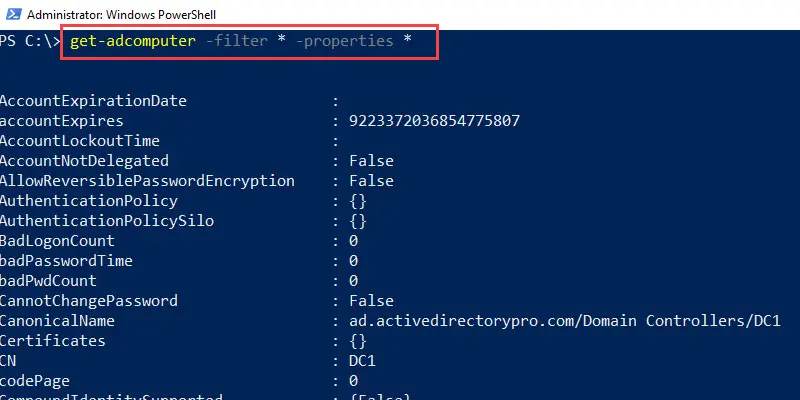
3. Get All Computers from an OU
Get-ADComputer -Filter * -SearchBase "OU=ADPRO Computers,DC=ad,DC=activedirectorypro,DC=com" This command will get all computers from a specific OU by using the -SearchBase parameter and the distinguishedName of the OU.
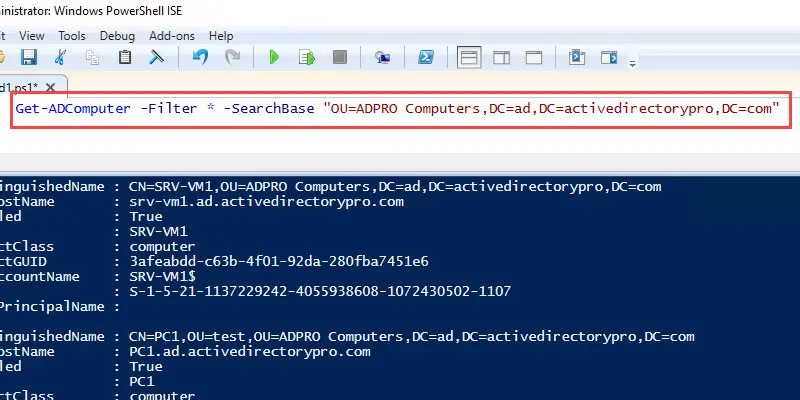
4. Get All Computers and Show Specific Properties
Get-ADComputer -Filter * | select name, EnabledThis command will get all computers and limit the output to display the name and enabled properties only.

5. Get All Enabled Computers
Get-ADComputer -Filter "Enabled -eq 'True'"This command uses the -filter option to limit the results to only enabled computers.
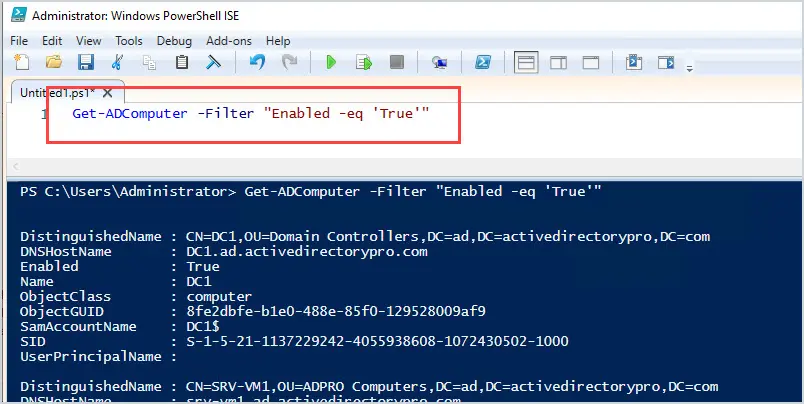
To limit the properties use the select option followed by the properties you want to display.
Get-ADComputer -Filter "Enabled -eq 'True'" | select Name, Enabled6. Get All Disabled Computers
Get-ADComputer -Filter "Enabled -eq 'false'" | select Name, EnabledThis command filters for enabled computers and limits the output to the name and enabled properties.

7. Get All Computers with a specific Name (Wildcard Search)
Get-ADComputer -Filter "Name -like 'SRV*'" | select Name, EnabledThis command searches for computers that start with srv in the name field.

8. Get All Computers and IP Addresses
Get-ADComputer -Filter * -properties * | select Name, Enabled,ipv4addressThis command gets all computers and displays the IP address of each computer.

9. Get All Computers lastlogondate
Get-ADComputer -Filter * -properties * | select name,lastlogondateThis command gets all domain computers and displays the lastlogondate value.
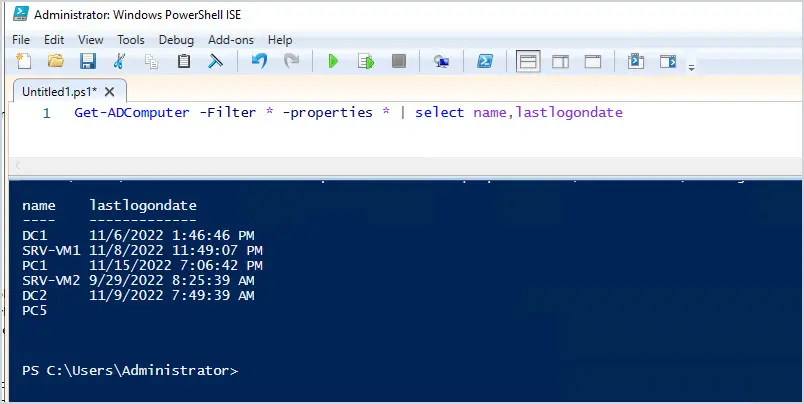
10. Get All Computers Last Modified Date from an OU
Get-ADComputer -Filter * -SearchBase "OU=ADPRO Computers,DC=ad,DC=activedirectorypro,DC=com" -properties *| select name, whenchangedThis command will get all computers from a specific OU and display the computer’s last modified date (whenchanged attribute).
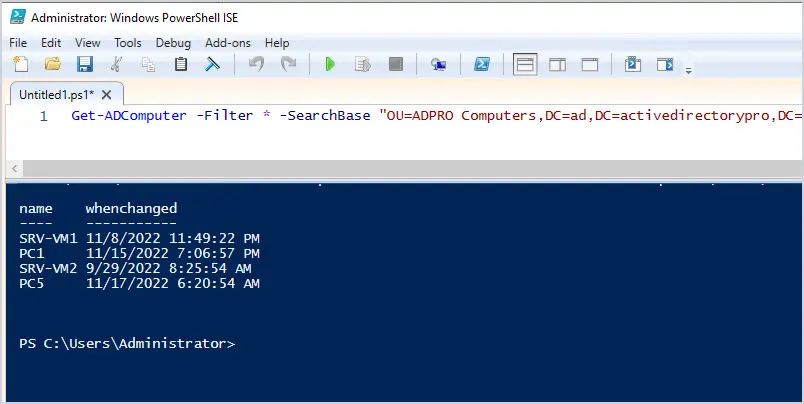
Easily Get AD Computers with the AD Pro Toolkit
The AD Pro Toolkit includes over 200 built-in Active Directory Reports for users, computers, groups, GPOs, and security. You can easily get all domain computers or computers from an OU.
You can customize the reports and build your own reports with the report builder.
Download AD Pro Toolkit and see how easy it is to create computer reports.
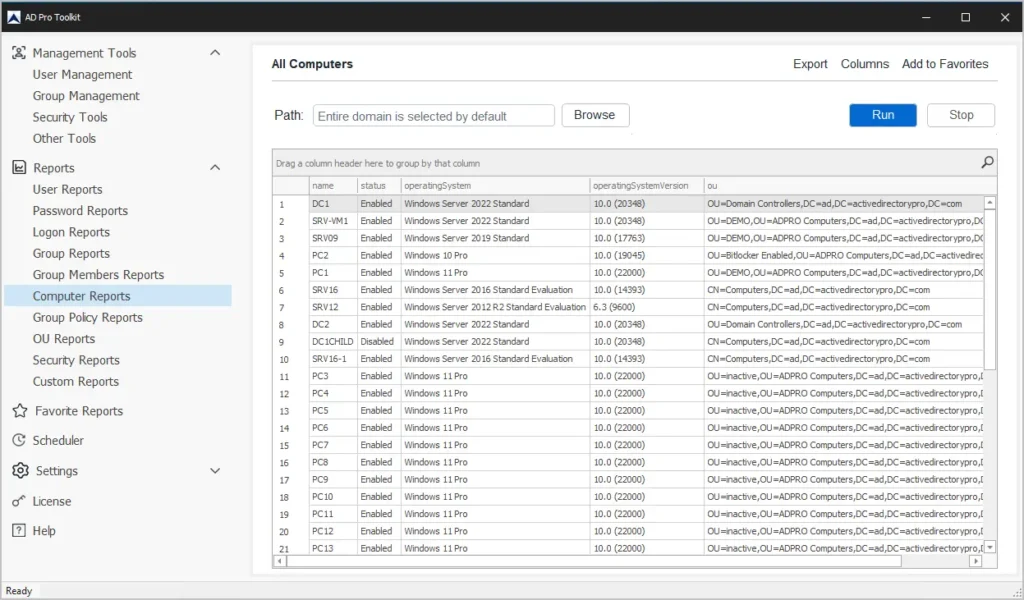
I hope you found this article useful. If you have questions or comments, please post them below. Refer to the Microsoft documentation to view the complete get-aduser syntax.


now do “get all ad computers that are NOT domain controllers”. copilot told me how to get Only domain controllers
Get-ADcomputer -Filter { (userAccountControl -band 0x2000)}
but i can’t figure out the opposite. “-bnot” is not working, and putting an ! in front of the parentheses in the filter is not working.
Here:
get-adcomputer -filter * -Properties name, enabled | select name, enabled
there is no need to use “-Properties name, enabled”, because these are standard properties that exist anyway.
Thanks a lot for the tips! included the one in commentaries. They are very useful!
Hi, Sergei.
You are welcome.
PS C:\Windows\system32> get-adcomputer -filter *
get-adcomputer : The term ‘get-adcomputer’ is not recognized as the name of a cmdlet, function, script file, or
operable program. Check the spelling of the name, or if a path was included, verify that the path is correct and try
again.
At line:1 char:1
+ get-adcomputer -filter *
+ ~~~~~~~~~~~~~~
+ CategoryInfo : ObjectNotFound: (get-adcomputer:String) [], CommandNotFoundException
+ FullyQualifiedErrorId : CommandNotFoundException
get-adcomputer requires the PowerShell Active Directory module? Do you have the RSAT tools installed?
This works in small environments in large environments running Get-Adcomputer -filter * and -Properties * will fall over.
In large environments I would not use -properties *, instead list only the properties you need.
get-adcomputer -filter * -Properties name, enabled | select name, enabled